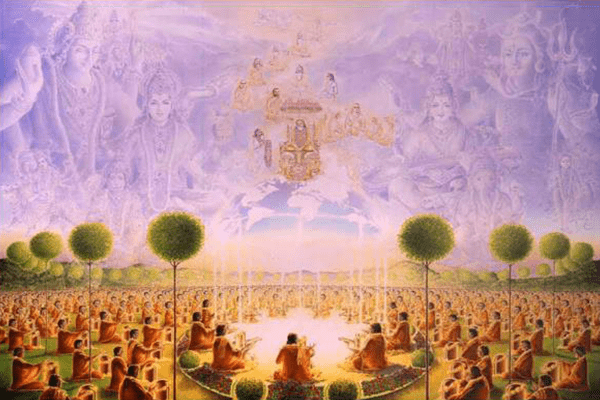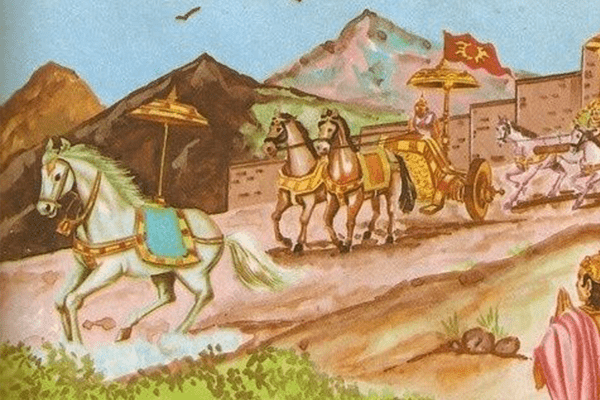
-
Scientific Aspects of Yagya
There are two basic energy systems in the physical world: Heat and Sound. In performing Yagya, these two energies, namely, the heat from Yagya’s fire and the sound of the Gayatri and other Mantras, are combined to achieve the desired physical, psychological and spiritual benefits.
The fumigation of specific substances in the Yagya – fire is a scientific method of subtulisation of matter into energy and expanding its potential and positive effects in the surrounding atmosphere. The electromagnetic waves generated thereby help in transmitting, at cosmic level, the desired sonic signals ‘stored’ in the Mantras, which are chanted during the process of sacrificing the special materials in the fire.
-
Fumigating Substances Used in Yagya
In order to get an idea of the various chemical changes which take place, it is essential to know the various substances offered in Yagya.
(A) Wood: Wood has to be dry and free from dust, insects and worms. The wood is cut into small sticks of varying lengths called Samidhas according to the size of the altar or Agnikunda.
The principal types of wood used are the following:–
- Sandal-wood (Santalum Album)
- Agar and Tagar wood (Aquilana Malaccensis and Valeriana Wallchii)
- Deodar (Cedrys Libani)
- Mango (Mangifera Indica)
- Dhak or Palash (Butea Frondosa)
- Bilva (Aegle Marmelos)
- Pipal (Ficus Religiosa)
- Bargad (Ficus Bengalensis)
- Shami (Proposis Spicigera)
- Gular (Ficus Glomerata)
In addition to wood, various Havishya or Havan samagri are
offered in Yagya
can be divided into the following four groups:(B) Odoriferous Substances:–
These are – saffron, musk, agar, tagar, chandan, illaychi, jayphal, javitri and camphor.
(C) Substances with Healthy Constituents:-
These are clarified butter (ghee), milk, fruits and cereals like wheat, rice, barley, til, kangu, munga, chana, arhar, masur or peas.
(D) Sweet Substances:–
These usually are – sugar, dried grapes, honey or chhuhara.
(E) Medicinal Herbs:–
These are used as per specific requirement.
Some common herbs are
Somalata or Giloya, Brahmi, Shankhpushpi, Nagkesar,
Mulhati,Red Chandan, Baheda, Sonth and Harad.Now-a-days Havan -samagri is readily available in the market consisting of the following substances in a crude powder form: Saw dust of sandal-wood and pine wood, the agar and tagar wood chips, kapurkachari, gugal, nagarmotha, balchhaar or jatamansi,narkachura, sugandhbala, illayachi, jayphal, cloves and dalchini.
-
Products of Combustion
At the outset, it can be said that the interpretation of process of combustion in a Yagya in a physical scientific terms is rather difficult due to the following reasons:
- The properties of substances which are used are vastly varying;
- The conditions under which combustion takes place remain unspecified. The products of combustion depend on the following
Factors like –
- The nature of substances used and their proportions;
- Temperature attained;
- Controlled supply of air and
- Interaction amongst the various products formed.
Vapourization of wood:
Besides complete combustion of cellulose material of wood, it is also subjected to vaporization. This happens due to the way Samidhas are arranged in the Agnikunda, the conditions of temperature and air supply which prevail in it.
Steam Volatilization of Odorous Substances:
The temperature attained in the Kunda varies between 250°C and 600°C, while in actual flames it can go as high as 1200°C to 1300°C. The boiling points of volatile constituents get diffused over in the surrounding atmosphere. Also when cellulose and other carbohydrates undergo combustion, steam is formed in copious quantities by the combination of hydrogen of organic substances with the oxygen. This is how the substances like thymol, eugenol, pinene, terpinol etc., are carried over in the surroundings and the aroma of a Yagya can besmelt even at a considerable distance.
In addition to steam, smoke is also given out in copious quantities and solid particles existing in a highly divided state offer sufficient surface for mechanical diffusion. Thus smoke also functions as colloidal particles for diffusion of volatile aromatic substances depending on temperature and direction of the wind.
Combustion of Fatty Substances:
The fatty substances used in Yagya are mainly ghee and other fatty substances of vegetable origin. Ghee helps in rapid combustion of cellulose of wood and keeps the fire alight. All fatty substances used are combinations of fattyacids, which volatilize easily. The combustion of glycerol portion gives acetone bodies, pyruvic aldehyde and glyoxal etc.The hydrocarbons produced in the reactions again undergo slow combustion and as a result methyl and ethyl alcohols, formaldehyde, acetaldehyde, formic acid and acetic acids are formed.
Photo-Chemical process :
When all the volatile substances are diffused in the surrounding atmosphere,these are further subjected to photochemical reactions in the sunlight. This may be the reason why it has been recommended that Yagya should be performed int he presence of strong sunlight. These changes occur in the ultra-violet and other short wavelength regions. The products of fumigation thus go photochemical decomposition, oxidation and reduction. To some extent even CO2is also reduced to formaldehyde as follows:
CO2 + H2O + 112,000 cal. = HCHO = O2From environmental angle, reduction of CO2 produced in
Yagya as above and liberation of oxygen cannot be
overemphasized.








